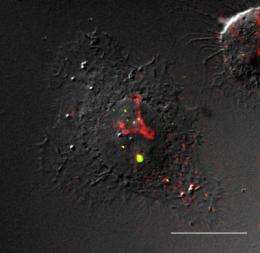Novel polymer delivers genetic medicine, allows tracking

Theresa M. Reineke, associate professor of chemistry in the College of Science, and colleagues in her lab at Virginia Tech and at the University of Cincinnati have developed a new molecule that can travel into cells, deliver genetic cargo, and packs a beacon so scientists can follow its movements in living systems.
"My lab has been trying to find a way to deliver genetic-based drugs into cells." said Reineke.
Scientists worldwide are using information from the human genome project as an approach to treat disease. Reineke's focus is cancer and cardiovascular disease. "Traditional drugs are aimed at treating disease at the protein level," she said. "Genetic drugs - such as those that can alter or control gene expression - aim to treat disease at the genetic level and have the added benefit of being more specific for their medicinal target." An example would be a genetic message that would arrest tumor growth.
A challenge has been that DNA and RNA drugs - pieces of genetic code that store information and instructions - cannot diffuse through the cell the way traditional small molecule drugs can. "We needed a vehicle to carry them into cells," said Reineke. One such vehicle has been engineered viruses. Reineke's group has been working on a more elegant solution. Their discovery is the topic of the PNAS article.
The scientists created novel polycations. A polycation is a polymer chain with positive charges, which is not too unusual. DNA itself is a polyanion, a polymer with negative charges. However, the Reineke Group's supramolecule has options. It contains chemistry (oligoethyleneamines) that binds and compacts nucleic acids - pieces of the DNA - into nanoparticles. It also incorporates a group of rare-earth elements known as lanthanides. The repackaged DNA is protected from damage as it travels into the cells and the lanthanides allow visualization of the delivery into cells.
"In our experiments, these delivery beacons provide the ability to track DNA delivery into living cells," said Reineke. "They provide the potential for tracking genetic therapies within the living body," she said.
At the nanometer or cellular scale, the researchers are able to track the polymers using sensitive microscopes, which capture the nanoparticle luminescence. At the sub-millimeter or tissue scale, magnetic resonance imaging (MRI) is used to see where the nanoparticles are going.
"This ability to track the movement and delivery of a gene-based drug provides an opportunity to understand the mechanism of delivery and monitor efficacy in real time, so that we can develop better materials for delivering genetic therapeutics and ultimately better treatments," Reineke said.
More information: The research was published in the September 23, 2009 online early edition of the Proceedings of the National Academy of Sciences (PNAS), in the article "Polymer beacons for luminescence and magnetic resonance imaging of DNA delivery." www.pnas.org/content/early/200 … /0904860106.abstract
Source: Virginia Tech (news : web)
















